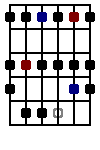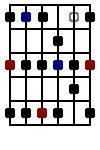In music, a scale is a set of musical notes that provides material for part or all of a musical work. Read about Scale Theory.
Why learn scales?[]
Because scales are the basis of almost everything in music. They are used in almost all compositions and improvisations in any musical genre. Learning and practicing scales greatly help to develop your hearing, to pick up various harmonies and melodies of different kind of genres, cultures and ages. Understanding scales also helps you to get a deeper knowledge of general music theory. Practicing and playing different scales (and in different ways) also helps you to map the whole fretboard, and memorize its notes. Mastering different scales is also a great way to improve your technique (speed, strenght, finger streching, finger independence, consistency in tempo/volume/tone, muting other strings when playing, picking technique, shifting between positions), to acquire different licks and phrases, to make up ascending and descending runs on the neck of the guitar. Learning and practicing scales is essential to develop your ability to express yourself by playing on the guitar what you hear inside your mind, when playing over various chord progressions (for example soloing, improvising) in different musical keys. Knowing several common (and exotic) scales is also essential when transcribing existing music. Knowing the shapes of a scale in different positions on the neck is a good thing in itself, but on higher levels it's inevitable to understand the theory behind scales; the notes that make up a scale, the intervals between its notes, the connection between certain minor and major scales, and the connection between different chords consisting of the notes of the same scale. In Western music theory there's simply no "music" without scales.
Fingering[]
With most scales you should assign one finger to each fret. On scales that require a stretch, you should move whichever finger is closest and leave the other fingers where they are.
Example: A minor
E |----------------------------5-7-8-| B |----------------------5-6-8-------| G |------------------5-7-------------| D |------------5-7-9-----------------| A |------5-7-8-----------------------| E |5-7-8-----------------------------| Finger |1 3 4 1 2 4 1 3 4 1 3 1 2 4 1 3 4 |
Major/Minor Scales[]
Movable Scale Shapes (Modes)[]
| Shape 1 (Ionean) |
Shape 2 (Dorian) |
Shape 3 (Phrygian) |
Shape 4 (Lydian) |
Shape 5 (Mixolydian) |
Shape 6 (Aeolian) |
Shape 7 (Locrian) |
Open Position Scale Shapes[]
| F major |
C major |
G major |
D major |
A major |
E major |
Pentatonic Scale[]
A scale with 5 notes that is based on the major scale. It is basicaly the major scale without the 4^ and 7^ scale instervals.
Movable Scale Shapes[]
| Shape 1 (Ionian) |
Shape 2 (Dorian) |
Shape 3 (Phrygian) |
Shape 4 (Mixolydian) |
Shape 5 (Aeolian - minor pentatonic) |
Other scales that everyone should know[]
These aren't going to be written out. Just learn the proceeding scales and relate these to them.
- Harmonic Minor: Natural Minor #7
- A B C D E F G# A
- Melodic Minor: Natural Minor #6, #7
- A B C D E F# G# A
- This scale is often played with a Natural minor when descending
- Half-Whole Diminished Scale: R, b2, b3, 4, 5, 6, 7
- C Half-Whole Diminished: C, C#, D#, E, F#, G, A, A#
- Useful for Jazz playing
- Hybrid Scale
- A Hybrid Scale: A, B, C, C#, D, D#, E, F#, G
- A combination of the A Major and A Minor blues scales. Note the use of chromatic (Successive half notes.) notes.
Template:Referencebox







